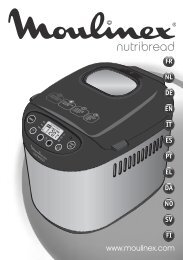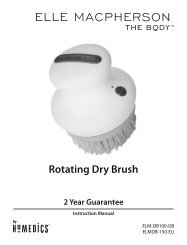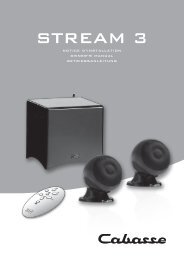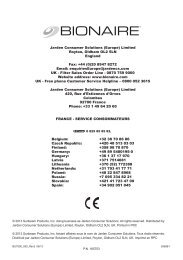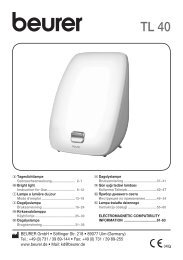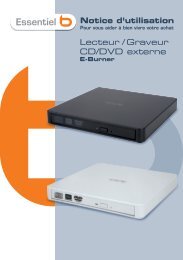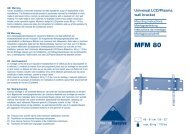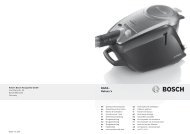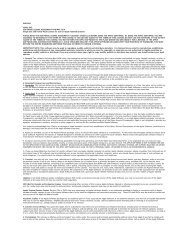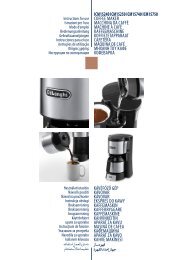19124 Iss 1 BM450 multilingual - Boulanger
19124 Iss 1 BM450 multilingual - Boulanger
19124 Iss 1 BM450 multilingual - Boulanger
Create successful ePaper yourself
Turn your PDF publications into a flip-book with our unique Google optimized e-Paper software.
adapting your own recipes<br />
After you have baked some of the recipes supplied, you<br />
may wish to adapt a few of your own favourites, which<br />
previously have been mixed and kneaded by hand. Start<br />
by selecting one of the recipes in this booklet, which is<br />
similar to your recipe, and use it as a guide.<br />
Read through the following guidelines to help you, and be<br />
prepared to make adjustments as you go along.<br />
● Make sure you use the correct quantities for the bread<br />
maker. Do not exceed the recommended maximum. If<br />
necessary, reduce the recipe to match the flour and<br />
liquid quantities in the breadmaker recipes.<br />
● Always add the liquid to the bread pan first. Separate<br />
the yeast from the liquid by adding after the flour.<br />
● Replace fresh yeast with easy blend dried yeast. Note:<br />
6g fresh yeast = 1tsp (5ml) dried yeast.<br />
● Use skimmed milk powder and water instead of fresh<br />
milk, if using the timer delay setting.<br />
● If your conventional recipe uses egg, add the egg as<br />
part of the total liquid measurement.<br />
● Keep the yeast separate from the other ingredients in<br />
the pan until mixing commences.<br />
● Check the consistency of the dough during the first few<br />
minutes of mixing. Bread machines require a slightly<br />
softer dough, so you may need to add extra liquid. The<br />
dough should be wet enough to gradually relax back.<br />
14<br />
removing, slicing and storing bread<br />
● For best results, once your loaf is baked, remove it<br />
from the machine and turn out of the bread pan<br />
immediately, although your bread maker will keep it<br />
warm for up to 1 hour if you are not around.<br />
● Remove the bread pan from the machine using oven<br />
gloves, even if it is during the keep warm cycle. Turn<br />
the pan upside-down and shake several times to<br />
release the cooked bread. If the bread is difficult to<br />
remove, try gently knocking the corner of the bread<br />
pan on a wooden board, or rotate the base of the shaft<br />
underneath the bread pan.<br />
● The kneader should remain inside the bread pan when<br />
the bread is released, however occasionally it may<br />
remain inside the loaf of bread. If so, remove it before<br />
slicing the bread, using a heat resistant plastic utensil<br />
to prise it out. Do not use a metal implement as this<br />
may scratch the non-stick coating on the kneader.<br />
● Leave the bread to cool for at least 30 minutes on a<br />
wire rack, to allow the steam to escape. The bread will<br />
be difficult to slice if cut hot.<br />
storing<br />
Home-made bread does not contain any preservatives so<br />
should be eaten within 2-3 days of baking. If not eating<br />
immediately, wrap in foil or place in a plastic bag and seal.<br />
● Crispy French-style bread will soften on storage, so is<br />
best left uncovered until sliced.<br />
● If you wish to keep your bread for a few days, store in<br />
the freezer. Slice the bread before freezing, for easy<br />
removal of the amount required.




